lies like truth: August 2010 Archives
 Every day I read articles in the press about how important it is for anyone involved in the arts world (or indeed, any world) to use social media as a way of marketing one's "product". I know how useful tools like Twitter and Facebook are from what I'm told by others. And technologies that enable organizations to mail out information to select members of their mailing lists or entire lists at the touch of a button has revolutionized the way we spread the word about what we're doing, reach new and familiar audiences, generate enthusiasm and even build funds.
Every day I read articles in the press about how important it is for anyone involved in the arts world (or indeed, any world) to use social media as a way of marketing one's "product". I know how useful tools like Twitter and Facebook are from what I'm told by others. And technologies that enable organizations to mail out information to select members of their mailing lists or entire lists at the touch of a button has revolutionized the way we spread the word about what we're doing, reach new and familiar audiences, generate enthusiasm and even build funds. What I struggle with though, is finding the time and mental capacity to both keep track of others' social media outpourings and develop my own. I've been feeling a bit stressed about it lately because I keep getting emails from Twitter telling me that someone wants to "follow" me via the tool, but I just can't bring myself to add tweeting to an already overwhelming amount of daily activities from writing this blog and filing articles to newspapers and magazines to doing all the fundraising, producing and hosting of a weekly public radio show and teaching.
I have a Facebook account which I rarely visit. I also have a Twitter account, which is an even bigger joke. I set up the account about 13 months ago as an aid for a class I was teaching to a bunch of teenagers on a summer school program on writing about theatre using different media. I haven't been to the Twitter website since, figured out how to send Tweets, or signed up to receive anyone else's.
The long and short of it that I'm swamped and don't have the mental capacity to add more regular activities to to my already buckling brainload.
I just about manage to keep up with this blog five days a week. VoiceBox, my weekly public radio and web project, has a Facebook and Twitter presence. But luckily for me, my wonderful intern, Victoria Lim, handles updates via those tools. If I were responsible for keeping people informed via Facebook and Twitter of what's going on with VoiceBox, I would very likely forget because I'm extremely overextended as it is with the business of producing and hosting the project. Maintaining the project website, remembering to send out an e-letter to my mailing list once a month updating people about the upcoming shows in the VoiceBox series or spreading other news is about as far as I can go at this point with the slim resources I have. I am so glad at least to be able to outsource the social media part the project.
I suppose the solution is to get to a point where I have enough money to hire someone to handle all the communication aspects of the project. But that's probably a way off. It's sort of a chicken and egg situation though, because if I were more actively using social media, maybe I'd be in a better position to generate the funds I need to actually be able to hire someone to take care of this stuff for me.
Facebooking, Tweeting, maintaining an active website and sending out emails to mailing list members are important activities in today's world. I just wish that I could understand how people manage to juggle all of this stuff though without feeling completely overwhelmed.
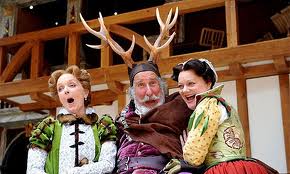
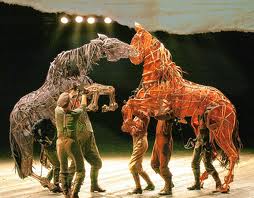 Just returned from a revivifying trip to the UK. Saw a couple of shows while I was there, which couldn't have been more different in terms of the emotions they provoked in me:
Just returned from a revivifying trip to the UK. Saw a couple of shows while I was there, which couldn't have been more different in terms of the emotions they provoked in me:The Merry Wives of Windsor at The Globe: Mark Shenton, a wonderful theatre commentator for The Stage, theatre junkie and all-round mensch, invited me to be his guest at the press night performance of Shakespeare's one-joke comedy. The one-joke in question is about fat people, which gets old pretty quickly. But the production, which features Christopher Benjamin as the play's overweight anti-hero Falstaff, moves swiftly and left me feeling elated by the end. Strong ensemble performances and director Christopher Luscombe's energetic direction, which sees the actors running all over the place including a boardwalk in the middle of the groundlings area and the musicians' balcony, keep the action bouncing along. But the acting often falls prey to too much hamming. One example of this is the several occasions when Mistresses Ford and Page talk about Falstaff behind his back with the intention of having him hear what they're saying. On the other hand, there are one or two startling moments of comedic styling. My favorite is when the male actors treat a corset from the laundry basket where Falstaff is supposedly secreted like it's diseased. They throw the object between them with disgust and can't wait to get rid of it. The kicker occurs when the corset finds its way into the hands of the effete Slender, who reacts completely differently to the rest of the male company: He shows genuine interest in the garment.
War Horse at The New London Theatre: The National Theatre's intelligent and deeply affecting production of a play adapted by Nick Stafford based on a novel by Michael Morpurgo made me cry. I think this has happened only once before to me at the theatre. The other time, the actors on stage were practicing very strange hypnotism effects on the audience, which is what caused the tears to flow, I'm pretty sure. Art about animals often pulls at people's heartstrings it's true, but Marianne Elliott and Tom Morris' production creates an impact not so much because of the animal-focused narrative (the play follows the fortunes of horses used in battle in the First World War) but because of the overwhelming combination of puppets and humans on stage and the epic nature of the storytelling which makes the most of dramatic moments of pathos and near-tragedy. The sinewy, life-size horse puppets created in collaboration with Handspring Puppet Company provide much of the production's visual impact. The horses seem extremely real because the humans that manipulate the puppets have captured equestrian movements and sounds that are utterly life-like, from the way in which the creatures eat to their nervous movements when in the presence of people they don't trust. The production is kinetic and intense. It's an emotional ride as we learn to care deeply both for the animals forced into combat and the humans whose lives are also at risk from warfare. The dramaturgy gets close to melodrama especially at the end (which I don't want to spoil so I won't say anything more about it.) We come close to a state of devastation in the final moments, which leads to a feeling of catharsis which is more releasing than anything I've ever experienced in a theatre before.
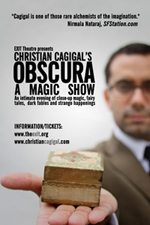 Three very contrasting cultural experiences this weekend. In brief:
Three very contrasting cultural experiences this weekend. In brief:1. Euouae at Old First Concerts: A new a cappella ensemble with an unpronounceable name gave its first concert at Old First Church on Van Ness Avenue on Friday evening. The repertoire consisted of sacred music from medieval France: the Tournai Mass, organum from the Magnus Liber of Leonin, and Obrecht's six voice Salve Regina. What was palpable for me was how much better the music sounded when the conductor, Steven Sven Olbash, wasn't conducting. I couldn't figure out why Olbash chose to direct some pieces but not others. But the flow of the phrases seemed so much more organic when the singers were left to their own devices. They listened to each other more carefully and conveyed a greater sense of the undulating, horizontal movement of the line. The women's chants suffered particularly from being led by Olbash. Wedged awkwardly into pews above the dais (as opposed to the men's choir which moved around more and was seated on the "stage" itself) the women were forced to follow the skinny maestro's fussy, angular movements much of the time. The music felt pedantic as a result and some of the edges, ragged. Olbash assembled a fine team of vocalists though. The music had me enraptured with its contorted dissonances and ethereal monophony. Plus, solo and small group passages scattered throughout the program beautifully showcased individual voices. For future concerts, the conductor should consider a) sitting out during concerts entirely or simply joining in as a singing member of the group, and b) taking a less academic approach to this repertoire in order to let the music breathe.
2. SF Chefs opening night after party at E&O Trading Co: Friday night switched gear entirely after the Euouae gig when I headed downtown with my friend to attend the opening night shindig for SF Chefs week at a spacious upscale Asian restaurant. The week-long culinary event is fast becoming a huge deal in the Bay Area's cultural life. It attracts the most happening names in the food, wine and spirits world as well as, seemingly, all the beautiful people of San Francisco. The E&O party featured delicious Asian street food (lamb lettuce wraps, spicy corn fritters, fried banana pieces, spring rolls etc) in plentiful amounts and unusual cocktails (the one I had with banana cream, vodka and curry powder was a bit of an acquired taste mind you.) Highlights of the evening for me were dancing to the cheesy 80s music provided by a DJ and listening to an absinthe maker from Paris and his partner, who's based here in the Bay Area, talk about the craftsmanship that's grown up around the culture of drinking the spirit. The two men collect absinthe-related ephemera such as old absinthe posters and special spoons and glasses that craftspeople have created to serve and advertise the beverage. They also spoke very interestingly about the hype that grew up around absinthe during the 80s and 90s when it was illegal in the US. Fascinating stuff.
3. Obscura: A Magic Show at the Exit Theatre: Local magician and actor Christian Cagigal performed his macabre jewel-box of a magic show before a packed house on Saturday night, his last performance in the present run. The tiny Exit Theatre Cafe stage was transformed into a sparkling den of stories and tricks. Cagigal gracefully wove spells into a variety of quirky cautionary tales about people who got on the wrong side of the devil (or a force of nature like him) and lost. He handled his sleight of hand escapades and mind games using a variety different sets of playing cards with the punctiliousness of a fastidious and bookish widowed uncle. Though the rhythm and pace of the show became somewhat predictable at about an hour in, Cagigal managed to maintain our attention. Cagigal returns to the Exit in October. It's well worth checking out the work of this most theatrical yet understated of magicians.
Finally, I am heading off to the UK for a couple of weeks starting this evening. I most likely won't be blogging while traveling. Please check in with "lies like truth" again starting on August 30.
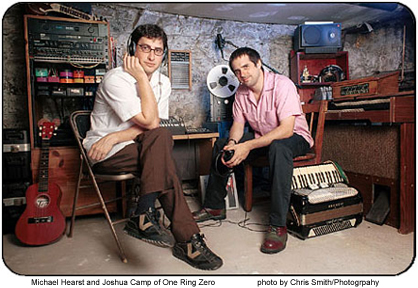 I have to take exception to one paragraph in John Jurgensen's otherwise expansive "The Secrets of Songwriters" article in yesterday's Wall Street Journal about lyricists.
I have to take exception to one paragraph in John Jurgensen's otherwise expansive "The Secrets of Songwriters" article in yesterday's Wall Street Journal about lyricists.The offending paragraphs says:
Divorced from a song, words on a page look like poetry--usually bad poetry. "Lyrics just don't hold up without the music," says Billy Collins, professor and former poet laureate. When his students argue that the lines by their favorite rock stars should be assessed as literature, he demurs: "I assure them that Jim Morrison is not a poet in any sense of the word."
I couldn't disagree more. What about Stephin Merritt of The Magnetic Fields? Even the simplest of his lyrics, like the words to "The Book of Love" stands alone without the music, in my opinion. Or R. Kelly's careening "Trapped in the Closet" song cycle? Or the amazing lyricists that penned words for the songs of Schubert like Heine?
I've been thinking about lyrics a lot lately as the upcoming VoiceBox show next Friday, August 20, is all about song words. The discussion features Michael Hearst (pictured left), one of the co-founders of the alt rock band One Ring Zero, who came into the KALW studios last week on a visit from New York to record the segment. Hearst is a wordsmith who can craft songs out of lyrics that have no pretentions to being literature whatsoever: One of his current projects is to create an album of songs out of the recipes of celebrity chefs like Mario Batali. But he also knows poetry when he sees it. Tune in to our discussion next Friday from 10-11pm on KALW 91.7 FM San Francisco or online at www.kalw.org. The show will also be available for on demand streaming for the week following the broadcast date here.
Speaking of the Wall Street Journal, the paper had another great article about singing in it from San Francisco by David LittleJohn all about the Merola opera program. Read it here.
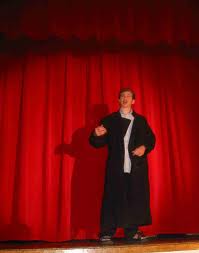 There are probably laws dictating that theatre companies need to make public safety announcements at the start of performances. But I wish companies wouldn't do it. There's no greater Joy Kill.
There are probably laws dictating that theatre companies need to make public safety announcements at the start of performances. But I wish companies wouldn't do it. There's no greater Joy Kill.You walk into the theatre, excited about what's about to happen. You buy a drink, take your seat, peruse your program and get ready to experience something unusual. A little thrill rushes through you at the prospect of being transported to a different world for a couple of hours. The auditorium hums with the buzz of expectation and goodwill. You engage the stranger sitting next to you in a conversation about the company's work or another production of the play you saw in Pennsylvania in the summer of '92. Everyone's in it together. The clock strikes eight and you're just about ready for the houselights to go down. But instead they go...up! And some awkward, stage-struck volunteer in a company T-shirt suddenly materializes before your eyes with a rambling monologue about how grateful the organization is to welcome you to its humble theatrical offering and how donations would be gratefully appreciated no matter how large or small, followed by the inevitable please-notice-your-nearest-emergency-exit and please-switch-off-your-cellphone reminders.
By the time the volunteer has finished talking, the spell has been completely -- and sometimes irreparably -- broken. What a shame.
If there were some way to prevent these speeches from happening, the theatre-going experience would be improved. You rarely hear people at a concert or public lecture telling the audience to silence its cellphones etc. Put the information on a board at the theatre doors if you have to; write a message on the front cover of the program; have the person who takes tickets or hands out programs voice a gentle reminder as he or she escorts audience members to their seats.
But please, please, please don't ruin those crucial first moments with an annoying -- and to my mind, unnecessary -- speech.
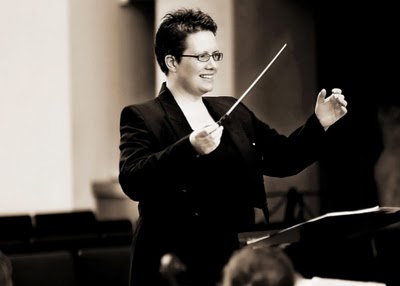 Community groups are up in arms in San Francisco about Proposition L -- the proposed Sit-Lie Law on San Francisco's November 2010 ballot, which, if passed, would mean that no one may sit or lie on a city side walk after 11 pm at night. One of the less likely outcomes of the news is the formation of a new vocal group.
Community groups are up in arms in San Francisco about Proposition L -- the proposed Sit-Lie Law on San Francisco's November 2010 ballot, which, if passed, would mean that no one may sit or lie on a city side walk after 11 pm at night. One of the less likely outcomes of the news is the formation of a new vocal group.Established by Dr. Kathleen McGuire, (pictured), the conductor of the San Francisco Gay Men's Chorus, Singers of the Streets (SOS) will bring homeless people and other people who like to sing together to protest the proposition and provide a social outlet.
McGuire is resigning from the Gay Men's Chorus this year to pursue this project, as well as an expanded role at the Community Women's Orchestra in Oakland and a new job as Officer of Culture for the Federation of Gay Games.
Inspired by the success of similar groups in Australia, Canada, Texas and the UK, McGuire hopes that SOS will:
1. Provide participants with a strong sense of purpose, achievement, team-building, socialization, community, and family.
2. Build participants' self-esteem, self-worth and self-respect via audience appreciation.
3. Give audiences a positive, personal, and human experience of people who are homeless and disadvantaged.
"With so many people being homeless in San Francisco, I've long thought that a group like this was something that we should start here," said McGuire. The Metropolitan Community Church Foundation approached the conductor two and a half years ago about launching a choir with homeless singers, but McGuire had too full a work schedule to devote her attentions to getting such a choir off the ground. "It was when I heard about Prop L, that I decided that I couldn't put the plan off any longer. That was the final straw. I told the Foundation that I'd start up the choir as a volunteer," McGuire said. "It's time for us to take a stand -- or a sit -- as the case may be."
The immediate goal for SOS is to work in tandem with Prop L protest groups such as "Sidewalks are for the People" to get Prop L overturned. The group will have its first rehearsal at the Metropolitan Community Church of San Francisco (MCCSF), located at 150 Eureka Street in the Castro neighborhood, on Wednesday September 8 from 11-1 pm. A free lunch will be provided by the Foundation. Subsequent meetings will follow the same pattern. The first performance is likely to take place at a fundraiser for Prop L opposers in October, the details of which are still be hammered out.
McGuire sees Prop L as an impetus to launch the group, but hopes to keep it going long beyond a resolution is fount for that particular piece of civil legislation. The main aim is to make music and forge a sense of community. To that end SOS will perform a diverse repertoire of popular songs in different styles. Numbers that the conductor might start with include such Prop L-astute tracks as "Sign, Sign Everywhere a Sign," "Don't Sleep in the Subway," "He Ain't Heavy, He's My Brother," and "Just a Stranger on a Bus."
McGuire plans to teach the music by call and response, using a guitar and the services of a volunteer pianist to assist in rehearsals. "People might not read music, so we'll sing things that are easy for people to catch on to in unison."
While some community organizations in San Francisco offer homeless and disadvantaged people opportunities to sing together, SOS will be different in that McGuire insists on a clear performance focus. "It's not just about participation," she says. "The choir's members are people who are normally ignored, so it's important that they are visible in the community and receive accolades for their singing. The first performance will very likely be rough around the edges, but the point is to get out there are be seen and help boost people's self-esteem."
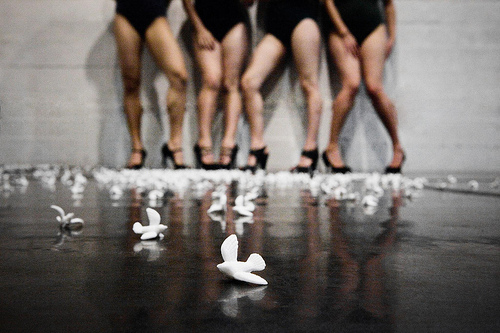 Do you ever feel like, culturally-speaking, you've been thrown back into another era? Depending on the experience in question, this can be a good or bad thing. Many great works of art owe their greatness to the fact that they make us feel like we've stepped into a different age from our own. But then there are those experiences that take you back in time unintentionally -- in other words, they're "old hat."
Do you ever feel like, culturally-speaking, you've been thrown back into another era? Depending on the experience in question, this can be a good or bad thing. Many great works of art owe their greatness to the fact that they make us feel like we've stepped into a different age from our own. But then there are those experiences that take you back in time unintentionally -- in other words, they're "old hat."I unfortunately faced the latter of these symptoms at the weekend when I went to CounterPULSE, a black box venue in San Francisco, to see two dance-theatre works by the organization's artists in residence, Jesse Hewit/Strong Behavior and Laura Arrington. The choreographers seemed to be attempting to say something fresh and interesting about what it means to be a woman / the nature of female sexuality with their works. Hewit's description of his piece from his website describes it as: "a dance theater work that visually and kinetically considers the high art of performing feminine subjectivities within contemporary narratives." Arrington's work is summarized on the CounterPULSE site as following "a cast of four women as they sing, scream, and dance toward resolution while contemplating the violence of femininity." Well, there it is.
By the time I staggered out of CounterPULSE on Saturday evening, I felt like I had been sitting in a basement theatre in New York's East Village circa 1962 but without the atmosphere and helpful drugs. The transportation to a bygone era was not a good thing.
The two works -- Tell them that you saw me by Hewit and Hot Wings (a still from the work is pictured above) by Arrington had a great deal in common. But far from complementing each other in revealing ways, the pieces appeared very samey as viewed back to back. The both had all-female casts. They both included overtly sexual imagery -- in Hewit's piece, the cast members took it in turn to simulate different sexual positions while the others stood around in a semi-circle and made appreciative comments e.g. about the artistry of one performer's "doggy style" posture. Arrington's piece started with the four cast members parading around with their skimpy leotard-wearing asses in the air and culminated with one performer dancing naked with a model deer strapped to her head. And both pieces featured intolerable amounts ear-splitting, blood-curdling screaming.
I had never seen Hewit's work before, but had heard of its merit from a renowned local choreographer friend of mine, who even made a cameo in Hewit's piece. And Arrington's company has impressed me in the past. I very much enjoyed the humor and innovative movement that the choreographer brought to a quirky piece I saw at The Garage last year on the theme of pirates and being stranded at sea.
The CounterPULSE show would have seemed outre and perhaps even profound as performed 50 years ago. But today it feels like so many cliches.
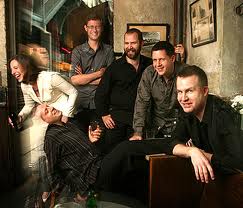 Spent just over 24 hours in Santa Cruz this past weekend. Caught the opening night concert of the Cabrillo Festival of Contemporary Music and a matinee performance of Shakespeare's Love's Labor's Lost at Shakespeare Santa Cruz.
Spent just over 24 hours in Santa Cruz this past weekend. Caught the opening night concert of the Cabrillo Festival of Contemporary Music and a matinee performance of Shakespeare's Love's Labor's Lost at Shakespeare Santa Cruz.I enjoyed the concert immensely. The house was packed and there was a pleasing variety in the programming. The first work, Mark-Anthony Turnage's Scherzoid, lurched and lollopped along like Mediaeval country faire music. The orchestra tackled the rhythmic challenges of the piece very well. The second work, Jennifer Higdon's On a Wire for orchestra and solo chamber ensemble was my favorite of the evening, not just musically, but visually too. The piece featured the brilliant sextet Eighth Blackbird (pictured) and careened between slow, spacious passages to jaunty, angular sections. The sight and sound of all the members of Eighth Blackbird clustered around a grand piano, each "bowing" strings inside the instrument by wrapping a piece of cord around a string and pulling it with two hands up and down to make a mournful sound a bit like whale-song was one of the most arresting experiences of my concert-going career to date. I suppose that it's from this activity -- those six birds on wires -- that the piece gets its title. The final offering of the evening, the world premiere of Michael Hersch's Symphony No. 3, was as intense and strung-out a work for orchestra as its possible to write. By his own admission, the composer was going through some personal issues during the writing process. The piece is relentlessly heady and extremely dark. I definitely felt the composer's pain.
Love's Labors Lost, which I caught on Saturday afternoon at the Festival Glen up on the University of California Santa Cruz campus, isn't a great play by any stretch of the imagination. But it can be fun and meaningful if done right as it poses some interesting questions about the dangerous and untenable nature of absolute behaviors and the inadequacy of language to convey our deepest feelings. The trouble with so many productions I've seen is that they tend to be overwrought. Scott Wentworth's take for Shakespeare Santa Cruz is no exception. The actors ham everything up. Some of the effects of this are funny. But most of the time, they're easy choices that quickly become wearing. One example is Corey Jones as the constable Dull. The part is small, but Jones plays his character like he's the lead. (Jones is essaying the title character in Othello too this season, and perhaps the largess of that role makes it hard for him to embrace the concept of playing a secondary character in Love's Labors Lost.) Jones' Dull is equipped with a goofy policeman's outfit and a lisp. Almost every move he makes on stage seems gimmicky, such as when he salutes and knocks off his cycle helmet.
I would quickly like to mention three other highlights of my trip to Santa Cruz. The first is the wine and cheese plate at 515 Kitchen and Cocktails, hands down my favorite evening eating and drinking spot in town. The second is brunch at Zachary's -- unbeatable value, sweet wait staff and excellent eggs. Finally, thank the celestial orbs for Rob Brezsny's "Free Will Astrology" column which the writer syndicates to the town's free weekly alt newspaper. Brezsny's stars are not like any others I've read before. It doesn't matter whether you believe that the alignment of the planets affects your ability to function or not. For Brezsny's horoscopes are great common sense and full of humor. He's also got a quirky, intellectual slant to him, and manages to make you think about the world of ideas while you're reading about what's in store for your life. His references effortlessly range between Greek philosophy and pop culture. I leave you with this week's Leo:
For a special episode of her TV talk show, Oprah Winfrey wanted a stage set that was fabricated out of chocolate. It took workers 1,400 hours to construct it. When the day came to unveil the decadent monument, Oprah offered her audience members the chance to tear it apart, eat it, and take it home as plunder. They dismantled it in half an hour. Let this be a cautionary tale, Leo. I dearly hope that the creation you're beginning to work on will endure for a long time and continue to provide meaning and pleasure far past the time it makes its initial splash. Build your baby to last.

Taro Hattori's paper sculpture currently on display at the SF Arts Commission's storefront installation gallery on Grove Street in Civic Center, San Francisco, is one of the most eye-catching works of art that I've ever seen displayed at the small, walk-by space.
The sculpture, which is made made out of carefully hewn and folded brown cardboard and white paper, depicts a building not unlike City Hall across the street floating precariously -- or perhaps even sinking -- in a sea of cardboard waves while origami seagulls circle the cupola.
If you look at the sculpture during the day, you can see the real City Hall, standing regal and erect across the street, reflected in the gallery window. The juxtaposition of the building's reflection and its artistic relief is both beautiful and slightly disconcerting. The birds don't look like they're dying. And the cardboard building looks too buoyant to sink. But there's a dangerous, lurching list to the whole thing, which -- especially when viewed in relation to the real building -- makes you wonder about about the solidity of the future of a city like San Francisco.<br><br>Part of the SF Arts Commission's "Now and When" group show, Hattori's work is on display until September 4.
The sculpture, which is made made out of carefully hewn and folded brown cardboard and white paper, depicts a building not unlike City Hall across the street floating precariously -- or perhaps even sinking -- in a sea of cardboard waves while origami seagulls circle the cupola.
If you look at the sculpture during the day, you can see the real City Hall, standing regal and erect across the street, reflected in the gallery window. The juxtaposition of the building's reflection and its artistic relief is both beautiful and slightly disconcerting. The birds don't look like they're dying. And the cardboard building looks too buoyant to sink. But there's a dangerous, lurching list to the whole thing, which -- especially when viewed in relation to the real building -- makes you wonder about about the solidity of the future of a city like San Francisco.<br><br>Part of the SF Arts Commission's "Now and When" group show, Hattori's work is on display until September 4.
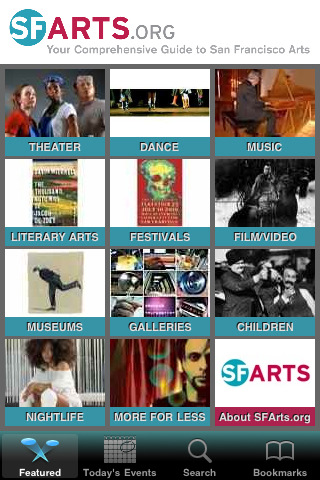 I just downloaded the new iPhone app for the SF Arts Guide, a web-based roundup of many arts events in the Bay Area organized under different headings such as "theatre", "dance" and "literary arts" by a bunch of pretty knowledgeable curators.
I just downloaded the new iPhone app for the SF Arts Guide, a web-based roundup of many arts events in the Bay Area organized under different headings such as "theatre", "dance" and "literary arts" by a bunch of pretty knowledgeable curators.I am fond of the SF Arts website. Though it's not comprehensive, it's fairly user friendly. However, I sometimes get frustrated at having to scroll down long columns to see what the curators recommend.
Designed by Dan Zeitman, a local web developer, the new iPhone app has a clean interface and some excellent features, though there are definitely kinks that need to be worked out:
Search: The search engine allows users to enter in keywords such as an artist name, title, genre or performance type to take them to information about a particular arts event. When I typed "Thrillpeddlers" into the search engine, I got the message "We did not find Thrillpeddlers in our event directory." I wonder whether the curated aspect of SF Arts means that some shows, companies and artists don't get picked up? Or is it simply that the search engine is not as "robust" as the press materials say it is.
Bookmarking: This feature is easy to use and convenient, allowing users to browse events and tap a button to save them in a list for later referral. Adding and deleting items is easy. And This feature also works off-line which is handy, especially in San Francisco where AT&T network coverage for the iPhone is patchy to say the least.
Social networking: The app enables people to share events via all the main social networking tools such as Facebook, Digg and Twitter. I personally am not all that interested in this feature, but I guess that many other people out there might be.
Map: Each entry includes a map so that users can figure out where an event is happening easily.
I think the SF Arts iPhone app is a welcome tool in as much as it provides information about a wide range of arts events that would take a lot more effort to find out about if you had to go to, say, the iPhone versions of The San Francisco Chronicle or other media sites where most people still go to find out about what's going on culturally in this part of the world.
However, there is definitely room for improvement. It would be great, for instance, if the SF Arts app would enable users to buy tickets directly from the iPhone and show reviews from the media of events. Also, the summaries of events don't seem to include such basic information as the phone number of the venue or the website URL. And you have to go to the map function to see the address, whereas it would be helpful to see that information on the "details" page for each event.
All i all though, it's a pretty nifty little app. I plan on using it when I'm out and about.
You can download the SF Arts Guide on iTunes at: http://itunes.apple.com/us/app/sf-arts-guide/id380603718?mt=8
P.S. I received the following update from Larry Larson, chief architect of the SFArts website and its database. Larry kindly gave me permission to publish his response to my blog entry:
"Thanks for your kind words about SFArts and the time and attention you have given our first iPhone app. Kary wanted to make sure I responded to your thoughts as soon as possible.
I am the chief architect of the website and its database. Dan Zeitman and I undertook the exercise of creating an iPhone conception of the site, and Dan did all of the iPhone specific coding. What was to be a quick 6 week job turned into a 7 month odyssey for all involved.
First, we know the app is not perfect. We have just submitted to Apple a revised version today, and some of the concerns you raise are directly addressed in that free (of course) update. Other concerns are high priority items."
 Since 1993, the Oakland Symphony Chorus has organized a really terrific summer singing program. Every Tuesday evening in July and August, the Chorus invites venerable local choral directors to lead members of the public in singing through masterworks of the classical repertoire accompanied by piano. The "Summer Sing-Ins" take place in a church in Oakland. Anyone can attend and attendees pay $10 for one event (or $50 for the entire six-evening series). The fee includes borrowing a score and intermission snacks.
Since 1993, the Oakland Symphony Chorus has organized a really terrific summer singing program. Every Tuesday evening in July and August, the Chorus invites venerable local choral directors to lead members of the public in singing through masterworks of the classical repertoire accompanied by piano. The "Summer Sing-Ins" take place in a church in Oakland. Anyone can attend and attendees pay $10 for one event (or $50 for the entire six-evening series). The fee includes borrowing a score and intermission snacks.I attended the event for the fist time last night and had a lot of fun. Like most classical music programming around here, the "Sing-Ins" attract a crowd of mostly white people aged 50 and above. I dream of a more diverse audience for this type of cultural happening. Still, people threw themselves at the Bach Magnificat and the Mozart C minor Mass with aplomb. And the conductor, Buddy James, (a professor of music at Cal State East Bay,) did a fine job of keeping us all on track, even though most of the time our heads were buried in our scores.
The singing was pretty rough -- most of us were sight-reading through the pieces after all. But polish wasn't the aim of the game. The joy of being in a room with so many people sharing this amazing music was all I needed. How often do most of us get to sing these works? Rarely. And, more to the point, when do us choral types get to sing through all the solos? Never.
One of the highlights for me and the friend I was with was singing through solos that were completely out of our ranges. My friend did a wonderful job singing the glorious soprano solo at the start of the Mozart in his lovely falsetto. And I enjoyed growling my way through a bass solo in the middle of the Bach.
The Summer Sing-Ins are coming to an end for 2010. There's only one left, in fact. Next week, Lynne Morrow, director of the Oakland Symphony Chorus, will put the public through its paces on the Verdi Requiem. Not to be missed.
In other news: San Francisco City Chorus is doing sightsings this summer of choral pieces. Tonight is Brahms Requiem, next week, Haydn and Mozart.
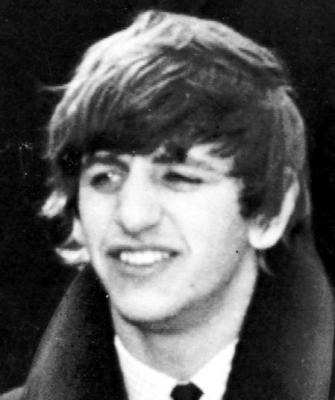 The idea that language is an arbitrary construct, a manmade and sometimes haphazard system created to help us get through our days without too many terrible misunderstandings, is an old one. But it resurfaced in a conversation I had yesterday in an unexpected context.
The idea that language is an arbitrary construct, a manmade and sometimes haphazard system created to help us get through our days without too many terrible misunderstandings, is an old one. But it resurfaced in a conversation I had yesterday in an unexpected context.The conversation centered on the naming of a type of long-form improvisation known among improv circles as "The Harold." The Harold came into being in 1967 in The Bay Area through the efforts of the seminal but now long-defunct San Francisco-based improv troupe, The Committee. It's basically a structure for organizing an improvised theatrical sketch that's organized in three sets of three scenes.
One of the troupe's members decided to name the format Harold, according to Committee founder Alan Myerson, because he was inspired by a scene in the Beatles movie Hard Day's Night. In the film, an interviewer asks Ringo Starr: "What do you call that hairstyle?" To which Ringo responds, "Arthur."
Hence, Q: What do you call that form of improvisation? A: Harold.
I read somewhere that a few members of The Committee later regretted giving the improv form that name. So I asked Alan what he might have called the format were he given the chance to re-title it. Without hesitation, the great improv producer and teacher answered:
"I would call it, The Chloe Veltman."
"Huh?"
Alan's reasoning was this: "The idea of The Harold came out of the immediate circumstances happening in the present and immediate situation in which they found themselves. That's what improvisation is. And that's what life is. You can't name the format we came up with back in 1967 anymore than you can name string theory. I don't know that there is a better name for The Harold than The Harold. But The Chloe Veltman would be fine as an alternative."
Speaking of improv, check out the San Francisco Improv Festival which starts on August 12 and runs till August 21.
 By far the best descriptor I heard regarding the Wanderlust Yoga and Music Festival which took place at Squaw Valley in Lake Tahoe this past weekend was "Burning Man for yogis."
By far the best descriptor I heard regarding the Wanderlust Yoga and Music Festival which took place at Squaw Valley in Lake Tahoe this past weekend was "Burning Man for yogis."Now in its second year, the weekend long event attracted a couple of thousand or more blissed-out hippies. Their identity could only be told apart from the crowd that flocks to Black Rock City in the Nevada desert each summer by virtue of the fact that they were all carrying yoga mats.
There also seems to be some crossover with Burning Man in terms of the kinds of sideshow-type events and attractions that dotted the Wanderlust compound, though on a much smaller scale. During the day, the Anusara Village, an area of the festival sponsored by the company behind the Anusara yoga style (a type of Hatha-based yoga founded by founded by John Friend in 1997) featured everything from circus arts to hoop dancing to sculptures. There was a lot of dust too, just like in the desert. By the time I was done with my third yoga session of the day, my pink yoga mat was almost grey in color.
At night, when the yoga sessions ended and the music and revelry began, drug-addled teens bopped around to live and DJ'd musical acts by the likes of Moby, Bassnectar and Brazilian Girls while yoga-inspired visuals played on screens behind the artists.
Not that the resemblance between Wanderlust and Burning Man should be overstated. Wanderlust is of course a fraction of the size of Burning Man. And, while Burning Man still attempts to maintain some vestige of non-commericality (even though many old-timers would say that this is a joke at this point), Wanderlust its unabashedly commercial. There were dozens of stands selling everything from high-end Manduka yoga mats to chilled coconuts.
I quite enjoyed the overall experience of the festival, though I think that the music could have generally been better integrated into the yoga. Yoga and music have a great deal in common, not least for their collective focus on channeling sound vibration. Yet, the general divide between the classes and the performances, schedule-wise, made me wonder why the organizers bothered pairing the two concepts in the first place.
For me personally, the highlight was attending a yoga class during which a live Kirtan-influenced rock band played. Having only ever done yoga to recorded music, I have to say that I was captivated by the live sounds. The New Agey music was not the sort of stuff that I would normally choose to listen to. But it very much helped to maintain the flow of the class (which was taught by three different master teachers in turn) and held my interest much more deeply than the music that I normally hear piped out of speakers at the yoga studio or gym.
